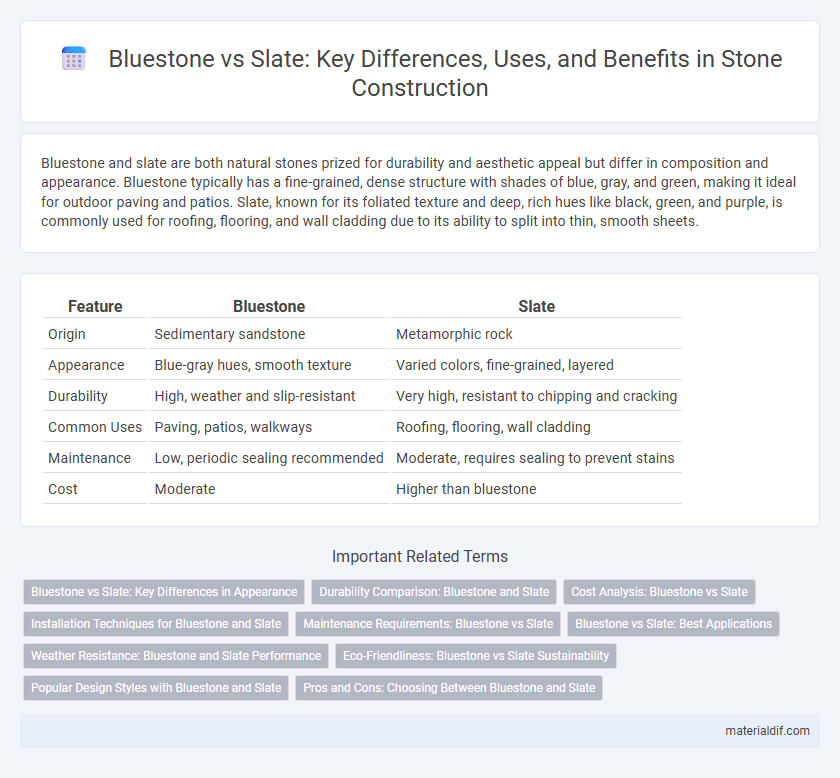Bluestone and slate are both natural stones prized for durability and aesthetic appeal but differ in composition and appearance. Bluestone typically has a fine-grained, dense structure with shades of blue, gray, and green, making it ideal for outdoor paving and patios. Slate, known for its foliated texture and deep, rich hues like black, green, and purple, is commonly used for roofing, flooring, and wall cladding due to its ability to split into thin, smooth sheets.
Table of Comparison
| Feature | Bluestone | Slate |
|---|---|---|
| Origin | Sedimentary sandstone | Metamorphic rock |
| Appearance | Blue-gray hues, smooth texture | Varied colors, fine-grained, layered |
| Durability | High, weather and slip-resistant | Very high, resistant to chipping and cracking |
| Common Uses | Paving, patios, walkways | Roofing, flooring, wall cladding |
| Maintenance | Low, periodic sealing recommended | Moderate, requires sealing to prevent stains |
| Cost | Moderate | Higher than bluestone |
Bluestone vs Slate: Key Differences in Appearance
Bluestone exhibits a dense, fine-grained texture with a predominantly blue-gray hue, often featuring subtle specks and a naturally matte finish. Slate, in contrast, presents a foliated, layered appearance with a broader color range including dark gray, green, purple, and black, characterized by its distinctive cleavage planes and smooth, slightly glossy surface. These visual distinctions make bluestone ideal for contemporary designs seeking uniformity, while slate is preferred for traditional settings with its varied, textured look.
Durability Comparison: Bluestone and Slate
Bluestone offers exceptional durability with high resistance to chipping and cracking, making it ideal for outdoor flooring and heavy-traffic areas. Slate is equally durable but tends to be more susceptible to flaking and surface wear over time, especially in freeze-thaw climates. Both stones provide longevity, but bluestone's denser composition generally ensures superior performance against physical stress and environmental factors.
Cost Analysis: Bluestone vs Slate
Bluestone typically costs between $10 to $20 per square foot, making it a more affordable option compared to slate, which averages $15 to $30 per square foot. Slate's higher price is due to its durability and aesthetic appeal, often used for premium projects requiring long-lasting stone surfaces. The installation costs for both stones are similar, but slate may require more skilled labor, adding to its overall expense in cost analysis.
Installation Techniques for Bluestone and Slate
Bluestone installation requires a stable, compacted base such as crushed stone or gravel to prevent shifting and ensure durability, with careful attention to proper drainage to avoid water damage. Slate installation involves securing thin, flat slabs on a firm substrate using mortar or adhesive, making it essential to maintain an even surface and precise alignment to accommodate slate's natural cleavage properties. Both materials benefit from professional cutting and sealing techniques to enhance longevity and aesthetic appeal in landscaping or flooring projects.
Maintenance Requirements: Bluestone vs Slate
Bluestone requires minimal maintenance, needing only periodic sealing to preserve its durability and color vibrancy, while slate demands more frequent sealing and careful cleaning to prevent surface damage and staining. Slate's natural cleft surface can trap dirt and debris, necessitating regular sweeping and gentle washing, whereas bluestone's smoother texture allows for easier debris removal. Both stones benefit from prompt spill cleanup and avoiding harsh chemicals, but bluestone generally offers a lower-maintenance solution for outdoor and indoor applications.
Bluestone vs Slate: Best Applications
Bluestone offers durability and a textured surface ideal for outdoor patios, walkways, and pool surrounds due to its slip-resistant properties and natural blue-gray hues. Slate, known for its fine-grained structure and vibrant color range, excels in indoor flooring, roofing, and decorative wall cladding where elegance and subtle layering are desired. Both stones withstand weathering, but bluestone's thickness and rougher texture suit high-traffic exterior applications better, while slate's smooth finish and variety make it preferable for refined interior designs.
Weather Resistance: Bluestone and Slate Performance
Bluestone exhibits excellent weather resistance due to its dense, fine-grained structure, making it highly durable in freeze-thaw conditions and resistant to water absorption. Slate also performs well under various weather conditions, offering superior resistance to moisture and frost thanks to its metamorphic properties and low porosity. Both stones maintain structural integrity over time, but bluestone's slightly higher porosity can lead to more absorption in extremely wet environments compared to slate.
Eco-Friendliness: Bluestone vs Slate Sustainability
Bluestone offers superior eco-friendliness due to its natural durability and minimal processing requirements, reducing environmental impact during extraction and installation. Slate, while also sustainable, often undergoes more intensive quarrying and finishing processes, increasing energy consumption and waste generation. Choosing bluestone supports sustainable landscaping by minimizing resource use and promoting long-lasting, low-maintenance applications.
Popular Design Styles with Bluestone and Slate
Bluestone is favored in contemporary and rustic design styles for its earthy blue-gray tones and textured surface, making it ideal for patios, walkways, and outdoor kitchens. Slate is popular in traditional and modern aesthetics due to its fine-grained structure and rich color variations, commonly used for roofing, flooring, and fireplace surrounds. Both stones offer durable, natural beauty, with bluestone lending a warm, casual vibe and slate providing a sleek, sophisticated finish.
Pros and Cons: Choosing Between Bluestone and Slate
Bluestone offers durability and a natural blue-gray hue that resists fading, making it ideal for outdoor patios and walkways, but it can be more porous and prone to staining compared to slate. Slate provides a sleek, dark appearance with excellent resistance to heat and moisture, perfect for roofing and indoor flooring, yet it tends to be more brittle and requires careful handling. Choosing between bluestone and slate depends on the desired aesthetic, durability needs, and maintenance willingness for specific applications.
Bluestone vs Slate Infographic

 materialdif.com
materialdif.com